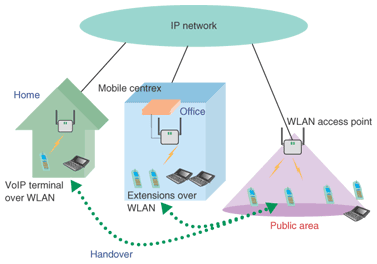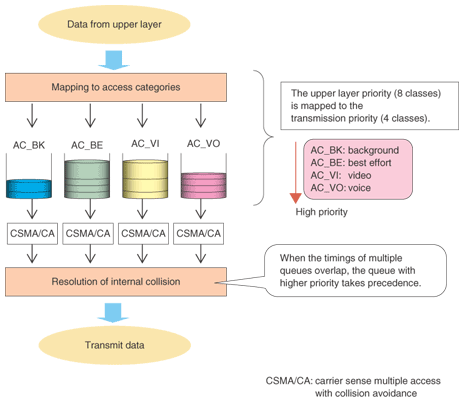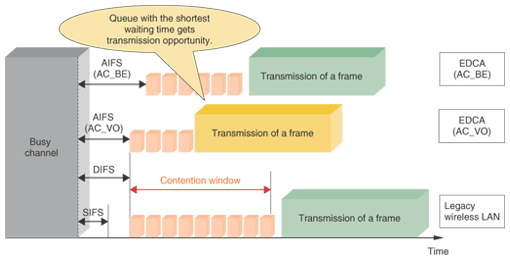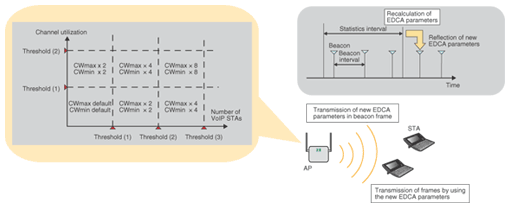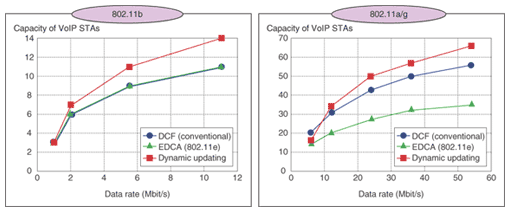 |
|||||
|
|
|||||
Vol. 5, No. 11, pp. 39–43, Nov. 2007. https://doi.org/10.53829/ntr200711sf6 Technique for Dynamically Updating EDCA Access Parameters for WLANsAbstractTechniques for improving the quality of communication on wireless local area networks (WLANs) that use the IEEE 802.11 standard are being researched and developed. In this article, we explain a technique for dynamically updating EDCA (enhanced distributed channel access) access parameters that increases the number of VoIP (voice over Internet protocol) terminals that can be accommodated on a WLAN.
1. Problems with video streaming and voice communication over WLANsIEEE 802.11 (Wi-Fi) wireless local area networks (WLANs) are widely used in homes, offices, and various other places, including some public spaces. An increasing number of applications are using WLANs based on Internet protocol (IP), and the number of users is increasing. Voice and video traffic now makes up an important part of wireless access services. For example, the way that voice applications are used over WLANs is shown in Fig. 1. Here, a mobile centrex is an internal telephone system in an office using a WLAN. The use of IP phones with WLANs in the home is also growing. Therefore, it would be convenient if one could use the same WLAN IP phone terminal for high-quality calls with seamless handover between office, home, and public areas. In general, web traffic and various data are mixed in both wireless and wired LANs, so it is important to protect voice and video traffic, which require stricter quality standards than other data. The quality of wireless communication is strongly dependent on the radio environment, which can change frequently because of interference or obstacles. Therefore, it is more difficult to control the communication quality of wireless LANs than that of wired LANs. Moreover, because many kinds of wireless devices connect to the access points (APs) in public access systems, there is a high probability of traffic being misrouted. Therefore, quality should be protected using all available techniques. Priority control is one solution.
2. Priority control techniques for WLANsIEEE 802.11e provides quality-of-service (QoS) functions to WLANs. This standard defines priority control functions for IEEE 802.11 systems with an enhanced distributed coordination function in IEEE 802.11e EDCA (enhanced distributed channel access). In EDCA, as shown in Fig. 2, packets from the upper layer are classified into four access categories (ACs) according to their priority: best effort (AC_BE), background (AC_BK), video (AC_VI), and voice (AC_VO). The packets are generally classified based on the TOS (type of service) field of the IP header or the VLAN (virtual LAN) tag, which is defined in 802.1Q. Each AC has its own EDCA access parameters, and they determine the priority of the AC. After the classification, the packets are stored in the queues for the ACs. Then, each AC executes the carrier sense multiple access with collision avoidance (CSMA/CA) procedure, which is the basic procedure for transmitting a frame in an IEEE 802.11 WLAN, in order to resolve internal collisions between ACs. As a result, one AC gets a transmission opportunity.
The EDCA frame transmission scheme based on CSMA/CA is shown in Fig. 3. The corresponding legacy transmission scheme is called the distributed coordination function (DCF). In DCF, a wireless station (STA) with frames to transmit starts the carrier sense procedure and checks whether the channel is empty or busy. The STA starts to send the frame after waiting for a time equal to the sum of the distributed inter-frame space (DIFS) interval, which is a fixed waiting time, and the contention window if the channel is not busy during the DIFS time. In EDCA, these transmission procedures are done independently in each AC. The AC whose waiting time reaches zero sooner than those of other ACs gets the transmission opportunity. The contention window is calculated from the number of slots, which is chosen randomly between CWmin and CWmax. These procedures prevent the collision of multiple frames transmitted at the same time. The size of the contention window is defined based on two EDCA access parameters: CWmin and CWmax. The CWmin is used when the frame is transmitted the first time. If the frame is retransmitted because of a collision or error, the size of the contention window is increased to reduce the probability of collision by extending the number of selectable slots. The contention window should not be bigger than CWmax defined as the maximum window size.
In EDCA, the STA uses an arbitration inter-frame space (AIFS) instead of DIFS as the fixed waiting time. While DIFS has a single waiting period, AIFS has a different value for each AC, with higher-priority ACs having shorter AIFSs. Therefore, the higher-priority ACs get more transmission opportunities than the lower-priority ones. Also, CWmin and CWmax are shorter for higher-priority ACs. EDCA has a transmission burst function in the short inter-frame space (SIFS) interval, which is the shortest waiting time defined in the IEEE 802.11 standard. The STA that has the right of transmission can send frames continuously during the transmission opportunity (TXOP). The TXOP limit is defined in the EDCA access parameters. TXOP limit = 0 shows that only a single frame can be sent per transmission opportunity. EDCA access parameters (AIFS, CWmin/CWmax, and TXOP) are set in each STA in advance. At the same time, a beacon frame is broadcast by the AP”Ēs EDCA parameter field and the AP can tell STAs what parameters they should use. An STA that received a beacon frame updates the EDCA parameters and uses them to transmit frames. Therefore, the AP can control the EDCA parameters of STAs that it is handling. 3. Dynamic updating of EDCA access parametersAlthough an AP can control the priority of ACs using EDCA, the default EDCA parameters of IEEE 802.11e are not optimal for every situation. For example, the default CWmin and CWmax parameters are set to small values because higher-priority ACs should have shorter waiting times. However, shorter contention windows increase the probability of collision because they limit the randomly chosen slot number when the contention window is small. Therefore, when STAs running VoIP (voice over Internet protocol) or video applications are present in the same channel, the frames often collide with each other. As a result, VoIP and video application have rather bad performance. Furthermore, the number of VoIP STAs that an AP can receive decreases because of this problem. The number of VoIP STAs per AP is important for mobile centrex service and public WLAN service because the ability of users to talk at the same time in one AP is one aspect of a convenient service and if the required number of APs can be reduced, this will enable reductions in equipment costs. Optimizing the EDCA parameters is an effective way to increase the simultaneous-call-handling capacity. However, if a fixed value is used to enlarge the contention window size to avoid collision, this will increase the end-to-end delay. In addition, the difference in contention window size between an STA that extends the contention window size and one that does not in a neighboring AP might cause a reversal of priorities of the traffic between those APs. Therefore, we are investigating dynamic updating of the contention window size according to the radio conditions. The dynamic updating technique is illustrated in Fig. 4. An AP counts the number of STAs as active VoIP stations and sends more traffic than a pre-defined threshold value in AC_VO during the measurement time. The AP increases the CWmin and CWmax values in all ACs, depending on the number of active VoIP STAs. When there are lots of active VoIP STAs, the probability of collision increases and degrades performance, so the extended contention window works well. The CWmin and CWmax are shown as multiples of 2 because they are expressed that way in the frame format of the IEEE 802.11 standard. We also change the values of CWmin and CWmax depending on channel utilization, i.e., the measured time for which the channel is in use. That is, we change them because the probability of collision decreases when the channel is heavily used. Additionally, only CWmax is changed when the AP knows there is a legacy DCF STA in a neighboring AP. This prevents a higher-priority AC that extended CWmin from getting a lower priority than the legacy DCF STAs. In this way, the number of VoIP STAs that can talk at the same time is increased.
Parameters are updated periodically and are calculated from static data. They are then applied to the AP and the field of the beacon frame, which is sent to the STA. The STA that received the beacon frame updates the EDCA parameters depending on the field of the beacon frame and uses the parameters when it transmits. The effect of our technique on VoIP STAs, as determined by computer simulation, is shown in Fig. 5. The VoIP traffic consisted of packets from a G.711 codec transmitted in both directions. In the simulation, we assumed that transmission bit errors could be ignored and we evaluated the quality on the basis of packet loss and delay between AP and STA. We also assumed a situation in which the only traffic was VoIP traffic. The graph shows that a dynamic updating technique could improve the capacity by 20% for high data rates compared with a legacy DCF, even though the capacity of EDCA decreased because of the high probability of collision.
One technical issue for this dynamic updating technique is that the priorities might be reversed between dynamically updated STAs and legacy STAs when there are neighboring APs in the same channel. However, this technique can prevent performance degradation in both APs in such a situation, so it adequately improves the overall performance. 4. Future plansIn the future, we intend to continue developing this technique for dynamically updating EDCA parameters and improving the quality of WLANs coordinated using admission control or other techniques. |
|||||








